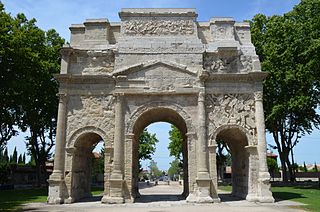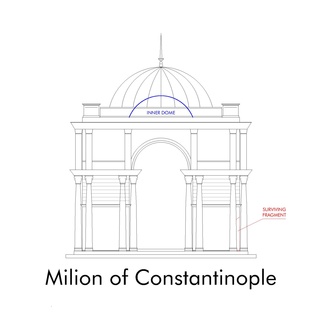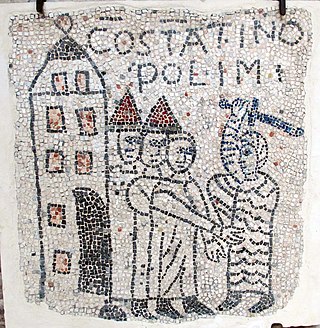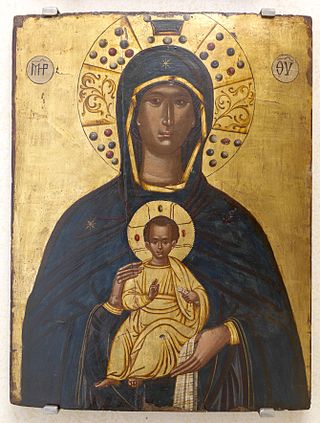
The Arc de Triomphe de l'Étoile is one of the most famous monuments in Paris, France, standing at the western end of the Champs-Élysées at the centre of Place Charles de Gaulle, formerly named Place de l'Étoile—the étoile or "star" of the juncture formed by its twelve radiating avenues. The location of the arc and the plaza is shared between three arrondissements, 16th, 17th (north), and 8th (east). The Arc de Triomphe honours those who fought and died for France in the French Revolutionary and Napoleonic Wars, with the names of all French victories and generals inscribed on its inner and outer surfaces. Beneath its vault lies the Tomb of the Unknown Soldier from World War I.

Constantinople became the capital of the Roman Empire during the reign of Constantine the Great in 330. Following the collapse of the Western Roman Empire in the late 5th century, Constantinople remained the capital of the Eastern Roman Empire, the Latin Empire (1204–1261), and the Ottoman Empire (1453–1922). Following the Turkish War of Independence, the Turkish capital then moved to Ankara. Officially renamed Istanbul in 1930, the city is today the largest city in Europe, straddling the Bosporus strait and lying in both Europe and Asia, and the financial centre of Turkey.

Piazza San Marco, often known in English as St Mark's Square, is the principal public square of Venice, Italy, where it is generally known just as la Piazza. Almost all the other urban spaces in the city are called campi ("fields"). The Piazzetta is an extension of the Piazza towards San Marco basin in its southeast corner. The two spaces together form the social, religious and political centre of Venice and are referred to together. This article relates to both of them.

The Fourth Crusade (1202–1204) was a Latin Christian armed expedition called by Pope Innocent III. The stated intent of the expedition was to recapture the Muslim-controlled city of Jerusalem, by first defeating the powerful Egyptian Ayyubid Sultanate. However, a sequence of economic and political events culminated in the Crusader army's 1202 siege of Zara and the 1204 sack of Constantinople, rather than the conquest of Egypt as originally planned. This led to the Partitio terrarum imperii Romaniae or the partition of the Byzantine Empire by the Crusaders and their Venetian allies leading to a period known as Frankokratia, or "Rule of the Franks" in Greek.

The Hippodrome of Constantinople, was a circus that was the sporting and social centre of Constantinople, capital of the Byzantine Empire. Today it is a square in Istanbul, Turkey, known as Sultanahmet Square.

A quadriga is a car or chariot drawn by four horses abreast and favoured for chariot racing in classical antiquity and the Roman Empire. The word derives from the Latin quadrigae, a contraction of quadriiugae, from quadri-: four, and iugum: yoke. In Latin the word quadrigae is almost always used in the plural and usually refers to the team of four horses rather than the chariot they pull. In Greek, a four-horse chariot was known as τέθριππον téthrippon.

A triumphal arch is a free-standing monumental structure in the shape of an archway with one or more arched passageways, often designed to span a road, and usually standing alone, unconnected to other buildings. In its simplest form, a triumphal arch consists of two massive piers connected by an arch, typically crowned with a flat entablature or attic on which a statue might be mounted or which bears commemorative inscriptions. The main structure is often decorated with carvings, sculpted reliefs, and dedications. More elaborate triumphal arches may have multiple archways, or in a tetrapylon, passages leading in four directions.

The Arc de Triomphe du Carrousel is a triumphal arch in Paris, located in the Place du Carrousel. It is an example of Neoclassical architecture in the Corinthian order. It was built between 1806 and 1808 to commemorate Napoleon's military victories in the Wars of the Third and Fourth Coalitions. The Arc de Triomphe de l'Étoile, at the far end of the Champs Élysées, is about twice the size; designed in the same year but not completed until 1836.

The Narva Triumphal Arch was erected in the vast Stachek Square, Saint Petersburg, in 1814 to commemorate the Russian victory over Napoleon.

François-Frédéric Lemot was a French sculptor, working in the Neoclassical style.

The Milion was a marker from which all distances across the Roman Empire were measured. Erected by Septimus Severus in the 3rd century AD in Byzantium, it was the Byzantine zero-mile marker, the starting-place for the measurement of distances for all the roads leading to the cities of the Byzantine Empire. It thus served the same function as the Golden Milestone in Rome's forum. The domed building of the Milion rested on four large arches, and it was expanded and decorated with several statues and paintings. It survived the sack of Constantinople in 1204 and the Ottoman conquest of Constantinople in 1453 but had disappeared by the start of the 16th century. During excavations in the 1960s, some partial fragments of it were discovered under houses in the area.

The Portrait of the Four Tetrarchs is a porphyry sculpture group of four Roman emperors dating from around 300 AD. The sculptural group has been fixed to a corner of the façade of St Mark's Basilica in Venice, Italy since the Middle Ages. It probably formed part of the decorations of the Philadelphion in Constantinople, and was removed to Venice in 1204 or soon after.

The Philadelphion was a public square located in Constantinople.
The Palace of Antiochos was an early 5th-century palace in the Byzantine capital, Constantinople. It has been identified with a palatial structure excavated in the 1940s and 1950s close to the Hippodrome of Constantinople, some of whose remains are still visible today. In the 7th century, a part of the palace was converted into the church–more properly a martyrion, a martyr's shrine–of St Euphemia in the Hippodrome, which survived until the Palaiologan period.

The Chalke Gate, was the main ceremonial entrance (vestibule) to the Great Palace of Constantinople in the Byzantine period. The name, which means "the Bronze Gate", was given to it either because of the bronze portals or from the gilded bronze tiles used in its roof. The interior was lavishly decorated with marble and mosaics, and the exterior façade featured a number of statues. Most prominent was an icon of Christ which became a major iconodule symbol during the Byzantine Iconoclasm, and a chapel dedicated to the Christ Chalkites was erected in the 10th century next to the gate. The gate itself seems to have been demolished in the 13th century, but the chapel survived until the early 19th century.

The sack of Constantinople occurred in April 1204 and marked the culmination of the Fourth Crusade. Crusader armies captured, looted, and destroyed parts of Constantinople, then the capital of the Byzantine Empire. After the capture of the city, the Latin Empire was established and Baldwin of Flanders was crowned Emperor Baldwin I of Constantinople in the Hagia Sophia.

The Amastrianum, also called Forum Amastrianum by modern authors, was a public square in the city of Constantinople. Used also as place for public mutilations and executions, it disappeared completely after the end of the Byzantine Empire.

Carmagnola or la Carmagnola is the traditional name of a porphyry head of a late Roman emperor, widely thought to represent Justinian, now placed on the external balustrade of St Mark's Basilica in Venice.

The Virgin Nikopoios also known as Panagia Nikopoios is a tempera painting by Thomas Bathas. Bathas was active in Heraklion, Venice, and Corfu during the second half of the 16th century. The painting follows the traditional Byzantine style characteristic of the traditional maniera greca. The painting also featured the Venetian style. The position of the Virgin and Child is the Nikopoios. The word Nicopeia is indicative of Constantinople. There are actually many different types.

The Treasury of St Mark's Basilica contains the church treasure or collection of sacred objects and reliquaries kept in St Mark's Basilica in Venice, Italy. The treasure constitutes the single best collection of Byzantine metalwork and enamels that survives, many of the items having been looted during the Fourth Crusade of 1204. The treasury also contains some significant artworks made for the basilica itself, but no longer used there.




























